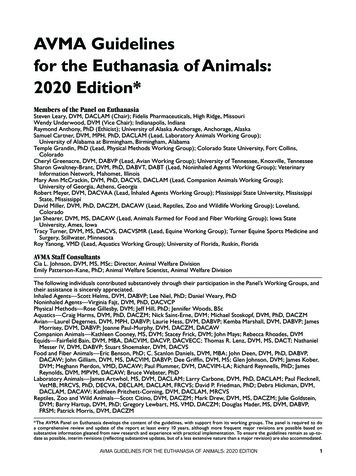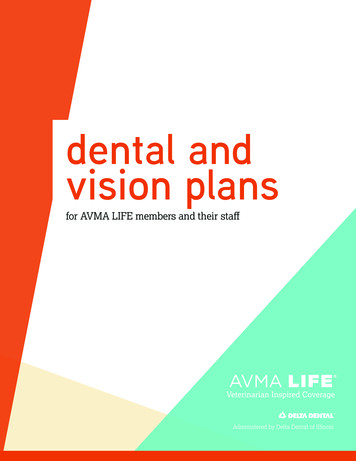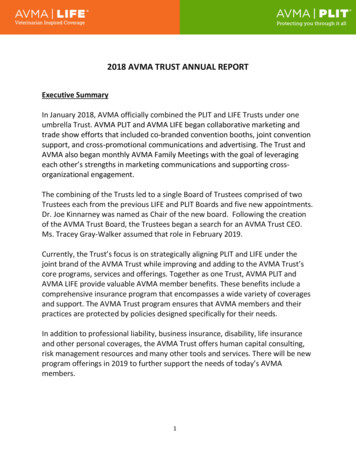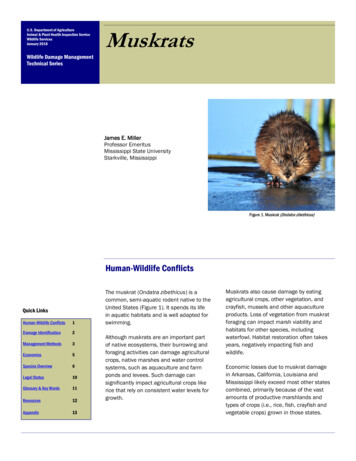
Transcription
AVMA Guidelinesfor the Euthanasia of Animals:2020 Edition*Members of the Panel on EuthanasiaSteven Leary, DVM, DACLAM (Chair); Fidelis Pharmaceuticals, High Ridge, MissouriWendy Underwood, DVM (Vice Chair); Indianapolis, IndianaRaymond Anthony, PhD (Ethicist); University of Alaska Anchorage, Anchorage, AlaskaSamuel Cartner, DVM, MPH, PhD, DACLAM (Lead, Laboratory Animals Working Group);University of Alabama at Birmingham, Birmingham, AlabamaTemple Grandin, PhD (Lead, Physical Methods Working Group); Colorado State University, Fort Collins,ColoradoCheryl Greenacre, DVM, DABVP (Lead, Avian Working Group); University of Tennessee, Knoxville, TennesseeSharon Gwaltney-Brant, DVM, PhD, DABVT, DABT (Lead, Noninhaled Agents Working Group); VeterinaryInformation Network, Mahomet, IllinoisMary Ann McCrackin, DVM, PhD, DACVS, DACLAM (Lead, Companion Animals Working Group);University of Georgia, Athens, GeorgiaRobert Meyer, DVM, DACVAA (Lead, Inhaled Agents Working Group); Mississippi State University, MississippiState, MississippiDavid Miller, DVM, PhD, DACZM, DACAW (Lead, Reptiles, Zoo and Wildlife Working Group); Loveland,ColoradoJan Shearer, DVM, MS, DACAW (Lead, Animals Farmed for Food and Fiber Working Group); Iowa StateUniversity, Ames, IowaTracy Turner, DVM, MS, DACVS, DACVSMR (Lead, Equine Working Group); Turner Equine Sports Medicine andSurgery, Stillwater, MinnesotaRoy Yanong, VMD (Lead, Aquatics Working Group); University of Florida, Ruskin, FloridaAVMA Staff ConsultantsCia L. Johnson, DVM, MS, MSc; Director, Animal Welfare DivisionEmily Patterson-Kane, PhD; Animal Welfare Scientist, Animal Welfare DivisionThe following individuals contributed substantively through their participation in the Panel’s Working Groups, andtheir assistance is sincerely appreciated.Inhaled Agents—Scott Helms, DVM, DABVP; Lee Niel, PhD; Daniel Weary, PhDNoninhaled Agents—Virginia Fajt, DVM, PhD, DACVCPPhysical Methods—Rose Gillesby, DVM; Jeff Hill, PhD; Jennifer Woods, BScAquatics—Craig Harms, DVM, PhD, DACZM; Nick Saint-Erne, DVM; Michael Stoskopf, DVM, PhD, DACZMAvian—Laurel Degernes, DVM, MPH, DABVP; Laurie Hess, DVM, DABVP; Kemba Marshall, DVM, DABVP; JamesMorrisey, DVM, DABVP; Joanne Paul-Murphy, DVM, DACZM, DACAWCompanion Animals—Kathleen Cooney, MS, DVM; Stacey Frick, DVM; John Mays; Rebecca Rhoades, DVMEquids—Fairfield Bain, DVM, MBA, DACVIM, DACVP, DACVECC; Thomas R. Lenz, DVM, MS, DACT; NathanielMesser IV, DVM, DABVP; Stuart Shoemaker, DVM, DACVSFood and Fiber Animals—Eric Benson, PhD; C. Scanlon Daniels, DVM, MBA; John Deen, DVM, PhD, DABVP,DACAW; John Gilliam, DVM, MS, DACVIM, DABVP; Dee Griffin, DVM, MS; Glen Johnson, DVM; James Kober,DVM; Meghann Pierdon, VMD, DACAW; Paul Plummer, DVM, DACVIM-LA; Richard Reynnells, PhD; JamesReynolds, DVM, MPVM, DACAW; Bruce Webster, PhDLaboratory Animals—James Artwhol, MS, DVM, DACLAM; Larry Carbone, DVM, PhD, DACLAM; Paul Flecknell,VetMB, MRCVS, PhD, DECVA, DECLAM, DACLAM, FRCVS; David P. Friedman, PhD; Debra Hickman, DVM,DACLAM, DACAW; Kathleen Pritchett-Corning, DVM, DACLAM, MRCVSReptiles, Zoo and Wild Animals—Scott Citino, DVM, DACZM; Mark Drew, DVM, MS, DACZM; Julie Goldstein,DVM; Barry Hartup, DVM, PhD; Gregory Lewbart, MS, VMD, DACZM; Douglas Mader, MS, DVM, DABVP,FRSM; Patrick Morris, DVM, DACZM*The AVMA Panel on Euthanasia develops the content of the guidelines, with support from its working groups. The panel is required to doa comprehensive review and update of the report at least every 10 years, although more frequent major revisions are possible based onsubstantive information gleaned from new research and experience with practical implementation. To ensure the guidelines remain as up-todate as possible, interim revisions (reflecting substantive updates, but of a less extensive nature than a major revision) are also accommodated.AVMA GUIDELINES FOR THE EUTHANASIA OF ANIMALS: 2020 EDITION1
Copyright 2020 by theAmerican Veterinary Medical Association1931 N. Meacham RoadSchaumburg, IL 60173The AVMA Guidelines for the Euthanasia of Animals: 2020 Edition (“work”) is licensed under the CreativeCommons Attribution-NonCommercial-NoDerivs 3.0 Unported License ). You are free to share, copy, distribute, or transmit the work, provided that proper attributionto the American Veterinary Medical Association is included (but not in any way that suggests that the AVMAendorses you or your use of the work). You may not use this work for commercial purposes, including without limitation any sale of the work, or modify or change the work in any way, or create derivative works fromit without permission of the American Veterinary Medical Association.ISBN 978-1-882691-54-8Version 2020.0.12AVMA GUIDELINES FOR THE EUTHANASIA OF ANIMALS: 2020 EDITION
CONTENTSPart I—Introduction and General CommentsI1 Preface .4I2 Historical Context and Current Edition .4I2.1 History of the Panel on Euthanasia .4I2.2 Substantive Changes Since the LastEdition.5I2.3 Statement of Use .5I3 What Is Euthanasia? .6I3.1 A Good Death as a Matter of HumaneDisposition .6I3.2 A Good Death as a Matter of HumaneTechnique .7I4 Euthanasia and Veterinary Medical Ethics .7I5 Evaluating Euthanasia Methods .9I5.1 Consciousness and Unconsciousness .10I5.2 Pain and Its Perception . 11I5.3 Stress and Distress .12I5.4 Animal Behavior .13I5.5 Human Behavior . 14I5.6 Sedation Versus Anesthesia . 15I6 Mechanisms of Euthanasia .16I7 Confirmation of Death.16I8 Disposal of Animal Remains . 17I9 Footnotes .18I10 References .18Part II—Methods of EuthanasiaM1 Inhaled Agents .22M1.1 Common Considerations.22M1.2 Principles Governing Administration .23M1.3 Inhaled Anesthetics .24M1.4 Carbon Monoxide .26M1.5 Nitrogen, Argon.27M1.6 Carbon Dioxide .28M2 Noninhaled Agents .32M2.1 Common Considerations .32M2.2 Routes of Administration .32M2.3 Barbituric Acid Derivatives.33M2.4 Pentobarbital Combinations .34M2.5 Tributame .34M2.6 T-61 .35M2.7 Ultrapotent Opioids .35M2.8 Dissociative Agents and α2-AdrenergicReceptor Agonists .35M2.9 Potassium Chloride and Magnesium Salts. 36M2.10 Chloral Hydrate and α-Chloralose .36M2.11 Alcohols .37M2.12 MS 222 (TMS) .37M2.13 Benzocaine Hydrochloride .38M2.14 Eugenol .38M2.15 2-Phenoxyethanol .39M2.16 Quinaldine (2-Methylquinoline,Quinalidine Sulfate) .39M2.17 Metomidate .39M2.18 Sodium Hypochlorite .39M2.19 Formaldehyde.40M2.20 Lidocaine Hydrochloride .40M2.21 Unacceptable Agents .40M3 Physical Methods .40M3.1 Common Considerations .40M3.2 PCB.41M3.3 NPCB .41M3.4 Manually Applied Blunt Force Traumato the Head .42M3.5 Gunshot .42M3.6 Cervical Dislocation.44M3.7 Decapitation .44M3.8 Electrocution .45M3.9 Kill Traps .46M3.10 Maceration.47M3.11 Focused Beam Microwave Irradiation .47M3.12 Thoracic (Cardiopulmonary, Cardiac)Compression .47M3.13 Adjunctive Methods .48M4 Footnotes.48M5 References .48Part III—Methods of Euthanasia by Species andEnvironmentS1 Companion Animals .56S1.1 General Considerations .56S1.2 Acceptable Methods .57S1.3 Acceptable With Conditions Methods.57S1.4 Adjunctive Methods.58S1.5 Unacceptable Methods .58S1.6 Special Considerations .58S1.7 Fetuses and Neonates .59S1.8 Euthanasia in Specific Environments .59S2 Laboratory Animals .60S2.1 General Considerations .60S2.2 Small Laboratory and Wild-CaughtRodents (Mice, Rats, Hamsters, Guinea Pigs,Gerbils, Degus, Cotton Rats, etc) .60S2.3 Laboratory Farm Animals, Dogs, Cats,Ferrets, and Nonhuman Primates.62S2.4 Laboratory Rabbits .63S2.5 Laboratory Fish, Amphibians, and Reptiles . 64S3 Animals Farmed for Food and Fiber.64S3.1 General Considerations .64S3.2 Bovids and Small Ruminants .65S3.3 Swine .72S3.4 Poultry .76S4 Equids .78S4.1 General Considerations .78S4.2 Methods.78S4.3 Special Cases and Exceptions .79S5 Avians .79S5.1 General Considerations .79S5.2 Methods .80S5.3 Eggs, Embryos, and Neonates .82S6 Fish and Aquatic Invertebrates .82S6.1 General Considerations .82S6.2 Finfish .83S6.3 Aquatic Invertebrates .89S7 Zoologic and Free-Ranging NondomesticAnimals .90S7.1 General Considerations .90S7.2 Captive Invertebrates .91S7.3 Captive Amphibians and Reptiles .92S7.4 Captive Nonmarine Mammals .94S7.5 Captive Marine Mammals .96S7.6 Free-Ranging Wildlife .97S7.7 Free-Ranging Marine Mammals .99S8 Footnotes .100S9 References .100Glossary. 110Appendices . 111AVMA GUIDELINES FOR THE EUTHANASIA OF ANIMALS: 2020 EDITION3
ABBREVIATIONSASICCASDEAEEGEPAHPAAcid-sensing ion channelControlled atmospheric stunningDrug Enforcement AgencyElectroencephalogram or electroencephalographicEnvironmental Protection AgencyHypothalamic-pituitary axisPart I—Introductionand General CommentsI1 PrefaceAnimal issues are no longer socially invisible,and increasingly, greater attention is being devotedto understanding the moral significance of experiences of animals and to taking into consideration thewelfare of animals. During the past half-century, efforts to ensure the respectful and humane treatmentof animals have garnered global attention.1,2 Concernfor the welfare of animals is reflected in the growthof animal welfare science and ethics. The former isevident in the emergence of academic programs, establishment of specialty colleges, implementation ofcurricular changes in veterinary colleges, proliferation of scientific journal articles, and development offunding streams committed either partially or exclusively to the study of how animals are impacted byvarious environments and human interventions. Thelatter has seen the application of numerous ethicalapproaches (eg, rights-based theories, utilitarianism,virtue ethics, contractarianism, pragmatic ethics) toassessing the moral value of animals and the nature ofthe human-animal relationship.1,3–9 The proliferationof interest in animal use and care, at the national andinternational levels, is also apparent in recent protections accorded to animals in new and amended lawsand regulations, institutional and corporate policies,and purchasing and trade agreements. Changing societal attitudes toward animal care and use have inspired scrutiny of some traditional and contemporarypractices applied in the management of animals usedfor agriculture, research and teaching, companionship, and recreation or entertainment and of animalsencountered in the wild. Attention has also been focused on conservation and the impact of human interventions on terrestrial and aquatic wildlife and theenvironment. Within these contexts, veterinariansprovide leadership on how to care well for animals,including how to relieve unnecessary pain and suffering.In creating the 2020 and 2013 edition of the AVMAGuidelines for the Euthanasia of Animals (Guidelines), the POE made every effort to identify and apply the best research and empirical information available. As new research is conducted and more practical experience gained, recommended methods of euthanasia may change. As such, the AVMA and its POE4IACUCMS 222NPCBPCBPOESNSInstitutional animal care and use committeeTricaine methanesulfonateNonpenetrating captive boltPenetrating captive boltPanel on EuthanasiaSympathetic nervous systemhave made a commitment to ensure the Guidelinesreflect an expectation and paradigm of continuousimprovement that is consistent with the obligationsof the Veterinarian’s Oath.10 As for other editions ofthe document, modifications of previous recommendations are also informed by continued professionaland public sensitivity to the ethical care of animals.While some euthanasia methods may be utilizedin slaughter (which refers to humane killing of animals destined for human consumption) or harvestand depopulation, recommendations related to humane slaughter and depopulation fall outside the purview of the Guidelines and are addressed by separatedocuments.The Guidelines set criteria for euthanasia, specify appropriate euthanasia methods and agents, andare intended to assist veterinarians in their exerciseof professional judgment. The Guidelines acknowledge that euthanasia is a process involving morethan just what happens to an animal at the time ofits death. Apart from delineating appropriate methods and agents, these Guidelines also recognize theimportance of considering and applying appropriatepre-euthanasia (eg, sedation) and animal handlingpractices, as well as attention to disposal of animals’remains.I2 Historical Contextand Current EditionI2.1 HISTORY OF THEPANEL ON EUTHANASIASince 1963 the AVMA has convened a POE to evaluate methods and potential methods of euthanasia forthe purpose of creating guidelines for veterinarianswho carry out or oversee the euthanasia of animals.The scope of the 1963 edition was limited to methods and recommendations applicable to dogs, cats,and other small mammals. Subsequent editions published in 1972 and 1978 encompassed more methodsand species (laboratory animals and food animals,respectively), and included additional informationabout animals’ physiologic and behavioral responsesto euthanasia (specifically, pain, stress, and distress),euthanasia’s effects on observers, and the economicfeasibility and environmental impacts of various approaches. In 1986 information on poikilothermic,aquatic, and fur-bearing wildlife was introduced; in1993 recommendations for horses and wildlife wereAVMA GUIDELINES FOR THE EUTHANASIA OF ANIMALS: 2020 EDITION
added; and in 2000 an update acknowledged a needfor more research on approaches suitable for depopulation. An interim revision by the AVMA Animal Welfare Committee in 2007 incorporated informationderived from an existing, but separate, AVMA policyon the use of maceration to euthanize day-old chicks,poults, and pipped eggs, and the name of the reportwas changed to the AVMA Guidelines on Euthanasia.In 2013 the process for compiling the POE’sreport was substantially changed to include morebreadth and depth of expertise in the affected species and environments in which euthanasia is performed. More than 3 years of deliberation by morethan 60 individuals, including veterinarians, animalscientists, behaviorists, psychologists, and an animalethicist, resulted in robust commentary and recommendations. A comment period allowed AVMA members an opportunity to provide input and share theirexperiences directly with POE members.The 2020 iteration of the Guidelines constitutesthe ninth edition of the POE’s report. The process forcompiling this edition was similar to that of the 2013edition. Two years of review, discussion, and revisionby the POE culminated in this edition. A commentperiod was held and the input from AVMA membershelps ensure the resulting document is not only scientifically robust, but practically sound.I2.2 SUBSTANTIVE CHANGESSINCE THE LAST EDITIONIn this interim update of the Guidelines, methods, techniques, and agents of euthanasia have beenupdated and detailed descriptions have been included to assist veterinarians in applying their professional judgment. Species-specific sections have been expanded or added to include more guidance for terrestrial and aquatic species kept for a variety of purposesand under different conditions. Where possible, appropriate flowcharts, illustrations, tables, and appendices have been used to clarify recommendations.Appendices 1 and 2 may be useful as a quick reference guide, but should never be used in lieu of thefull text of the doucment by those performing euthanasia. All illustrations and figures have been moved toAppendix 3 of the document.Some of the more significant changes are as follows: Language was added to clarify the distinction between sedation and anesthesia. Specifically, animals under sedation may be aroused to a consciousstate with sufficient stimulation. Recognizing thisis critical when categorizing the effects of agentsand distinguishing even deep states of sedationfrom unconsciousness. The conditions for the use of CO2 with rodents inthe laboratory have changed from a recommended10% to 30% of the chamber or cage volume/minto a recommended 30% to 70% of the chamber orcage volume/min. The extensive literature used tomake this recommendation is cited and the AVMAappreciates the proactive efforts made by the international research community to provide theevidence needed to make this determination. Euthanasia techniques appropriate for use withrabbits raised for meat are categorized and described. This material is located in the LaboratoryAnimals section to place them with other techniques used with these species. The Animals Farmed for Food and Fiber sectionhas been expanded to include American bison, water buffalo, camelids, and cervids. Updates to theapplication of captive bolt in several species havebeen made and new illustrations are available toassist veterinarians in proper usage. In the Avians section the recommendation forwhen avian embryos achieve the potential for perception has been amended from 50% to 80% of incubation for all avian eggs. This recommendationshould be applied across avians with considerationfor species-specific differences in developmentand using the best available data.I2.3 STATEMENT OF USEThe Guidelines are designed for use by membersof the veterinary profession who carry out or overseethe euthanasia of animals. As such, they are intendedto apply only to nonhuman species.The species addressed by the practice of veterinary medicine are diverse. A veterinarian experienced with the species of interest should be consulted when choosing a method of euthanasia, particularly when little species-specific research on euthanasiahas been conducted. Methods and agents selectedwill often be situation specific, as a means of minimizing potential risks to the animal’s welfare andpersonnel safety. Given the complexity of issues thateuthanasia presents, references on anatomy, physiology, natural history, husbandry, and other disciplinesmay assist in understanding how various methodsmay impact an animal during the euthanasia process.Veterinarians performing or overseeing euthanasia must assess the potential for animal distressdue to physical discomfort, abnormal social settings,novel physical surroundings, pheromones or odorsfrom nearby or previously euthanized animals, thepresence of humans, or other factors (including impact on the environment and other animals). In addition, human safety and perceptions, availabilityof trained personnel, potential infectious diseaseconcerns, conservation or other animal populationobjectives, regulatory oversight that may be speciesspecific, available equipment and facilities, optionsfor disposal, potential secondary toxicity, and otherfactors must be considered. Human safety is of utmost importance, and appropriate safety equipment,protocols, and knowledge must be available beforeanimals are handled. Advance preparation includesprotocols and supplies for addressing personnel injury due to animal handling or exposure to drugsand equipment used during the process. Once eutha-AVMA GUIDELINES FOR THE EUTHANASIA OF ANIMALS: 2020 EDITION5
nasia has been carried out, death must be carefullyverified. All laws and regulations pertaining to thespecies being euthanized, the methods employed,and the disposal of the animal’s remains and/or anywater containing pharmaceuticals used for euthanasia must be followed.The POE’s objective in creating the Guidelines isto provide guidance for veterinarians about how toprevent and/or relieve the pain and suffering of animals that are to be euthanized. While every effort hasbeen made to identify and recommend appropriateapproaches for common species encountered undercommon conditions, the POE recognized there willbe less than perfect situations in which a recommended method of euthanasia may not be possible and amethod or agent that is best under the circumstanceswill need to be applied. For this reason, although theGuidelines may be interpreted and understood by abroad segment of the general population, a veterinarian should be consulted in their application.I3 What Is Euthanasia?Euthanasia is derived from the Greek terms eumeaning good and thanatos meaning death. Theterm is usually used to describe ending the life of anindividual animal in a way that minimizes or eliminates pain and distress. A good death is tantamount tothe humane termination of an animal’s life.In the context of these Guidelines, the veterinarian’s prima facie duty in carrying out euthanasiaincludes, but is not limited to, (1) their humane disposition to induce death in a manner that is in accordwith an animal’s interest and/or because it is a matterof welfare, and (2) the use of humane techniques toinduce the most rapid and painless and distress-freedeath possible. These conditions, while separate, arenot mutually exclusive and are codependent.Debate exists about whether euthanasia appropriately describes the killing of some animals at theend of biological experiments11 and of unwanted shelter animals. The Panel believes that evaluating the social acceptability of various uses of animals and/or therationale for inducing death in these cases is beyondits purview; however, current AVMA policy supportsthe use of animals for various human purposes,12 andalso recognizes the need to euthanize animals thatare unwanted or unfit for adoption.13 Whenever animals are used by humans, good animal care practicesshould be implemented and adherence to those goodpractices should be enforced. When evaluating ourresponsibilities toward animals, it is important to besensitive to the context and the practical realitiesof the various types of human-animal relationships.Impacts on animals may not always be the center ofthe valuation process, and there is disagreement onhow to account for conflicting interspecific interests.The Panel recognizes these are complex issues sincehow to bring about a “good death” for animals is regarded as “essentially contested” (morally and conceptually),14 raising concerns across a large number6of domains, including scientific, ethical, economic,environmental, political, and social.I3.1 A GOOD DEATH AS AMATTER OF HUMANE DISPOSITIONHumane disposition reflects the veterinarian’sdesire to do what is best for the animal and serves tobring about the best possible outcome for the animal.Thus, euthanasia as a matter of humane dispositioncan be either intent or outcome based.Euthanasia as a matter of humane disposition occurs when death is a welcome event and continuedexistence is not an attractive option for the animalas perceived by the owner and veterinarian. Whenanimals are plagued by disease that produces insurmountable suffering, it can be argued that continuingto live is worse for the animal than death or that theanimal no longer has an interest in living. The humane disposition is to act for the sake of the animal orits interests, because the animal will not be harmedby the loss of life. Instead, there is consensus thatthe animal will be relieved of an unbearable burden.As an example, when treating a companion animalthat is suffering severely at the end of life due to adebilitating terminal illness, a veterinarian may recommend euthanasia, because the loss of life (and attendant natural decline in physical and psychologicalfaculties) to the animal is not relatively worse compared with a continued existence that is filled withprolonged illness, suffering, and duress. In this case,euthanasia does not deprive the animal of the opportunity to enjoy more goods of life (ie, to have moresatisfactions fulfilled or enjoy more pleasurable experiences). And, these opportunities or experiences aremuch fewer or lesser in intensity than the presenceor intensity of negative states or affect. Death, in thiscase, may be a welcome event and euthanasia helpsto bring this about, because the animal’s life is notworth living but, rather, is worth avoiding.Veterinarians may also be motivated to bringabout the best outcome for the animal. Often, veterinarians face the difficult question of trying to decide(or helping the animal’s owner to decide) when euthanasia would be a good outcome. In making this decision many veterinarians appeal to indices of welfareor quality of life. Scientists have described welfare ashaving 3 components: that the animal functions well,feels well, and has the capacity to perform behaviorsthat are innate or species-specific adaptations15–17 (analternative view is also available18). An animal hasgood welfare if, overall, its life has positive value forit. When an animal no longer continues to enjoy goodwelfare (when it no longer has a life worth living because, on balance, its life no longer has positive valuefor it, or will shortly be overcome by negative states),the humane thing to do is to give it a good death. Euthanasia relieves the animal’s suffering, which is thedesired outcome.AVMA GUIDELINES FOR THE EUTHANASIA OF ANIMALS: 2020 EDITION
I3.2 A GOOD DEATH AS AMATTER OF HUMANE TECHNIQUEWhen the decision has been made to euthanizeand the goal is to minimize pain, distress, and negative effect to the animal, the humaneness of the technique (ie, how we bring about the death of animals)is also an important ethical issue. As veterinariansand human beings it is our responsibility to ensurethat if an animal’s life is to be taken, it is done withthe highest degree of respect, and with an emphasison making the death as painless and distress free aspossible. When euthanasia is the preferred option,the technique employed should result in rapid lossof consciousness followed by cardiac or respiratoryarrest and, ultimately, a loss of brain function. In addition, animal handling and the euthanasia techniqueshould minimize distress experienced by the animalprior to loss of consciousness. The POE recognizedthat complete absence of pain and distress cannot al
assessing the moral value of animals and the nature of the human-animal relationship.1,3-9 The proliferation of interest in animal use and care, at the national and international levels, is also apparent in recent protec-tions accorded to animals in new and amended laws and regulations, institutional and corporate policies,










